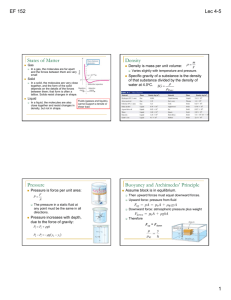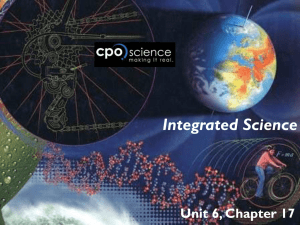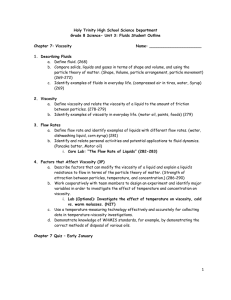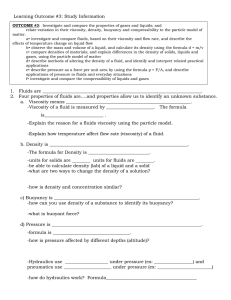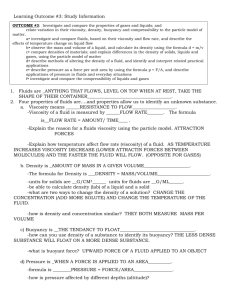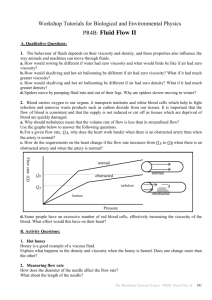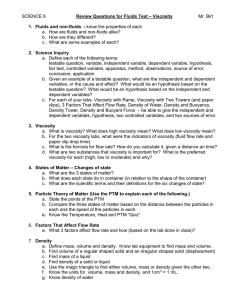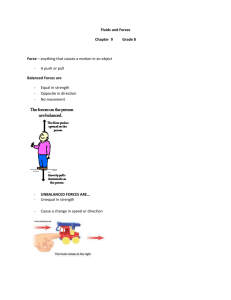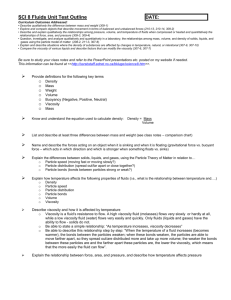Unit 6: Properties of Matter Ch 17: Properties of Matter
advertisement
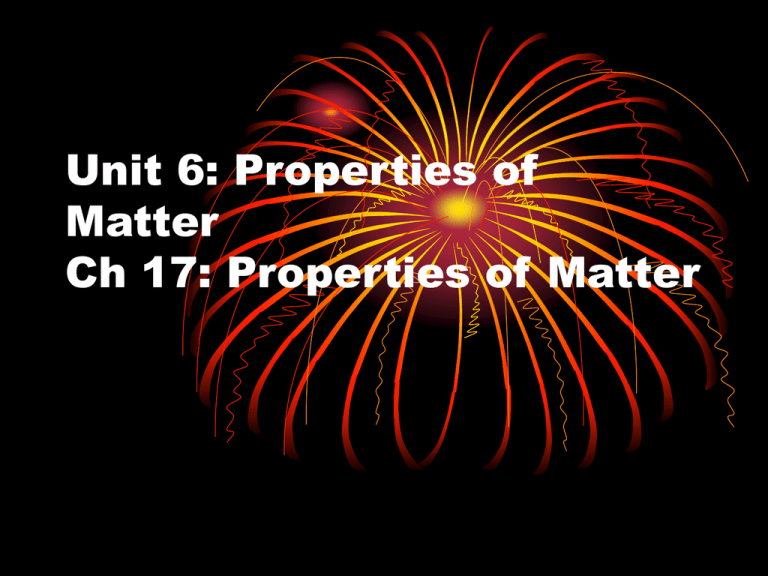
Unit 6: Properties of Matter Ch 17: Properties of Matter • 17.1 • 17.2 • 17.3 • 17.4 Properties of Solids Density of Fluids Buoyancy of Fluids Viscosity of Fluids Chapter 17 Learning Goals • Learn the definitions of terms used to describe properties of matter. • Learn how to calculate the density of solids. • Learn how to find the density of liquids and use your understanding to make a density column. • Use a density column to predict the density of a solid. • Investigate how the shape of an object can determine whether it floats or sinks. • Compare the weight of an object with the weight of the water it displaces. • Learn why certain fluids are more viscous than others. • Measure the viscosity of fluids using a viscometer. • Compare the properties of viscosity and the Chapter 17 Vocabulary Terms • • • • • brittleness buoyancy density elasticity hardness • malleability • tensile strength • viscosity 17.1 Properties of Solids I. Chemical Properties A. The way a substance reacts with other substances to form new substances with different properties B. Reactivity 1. the ability of a substance to chemically combine with another substance 2. ie – iron reacts with oxygen to form rust II. Physical Property A. A characteristic of a substance that be observed or measured without changing the composition of the substance B. Many physical properties can be observed using your five senses C. Properties help us distinguish between different types of matter D. Properties of Solids 1. density 2. hardness 3. elasticity 4. brittleness 5. malleability 6. tensile strength 7. Ability to conduct electricity 8. Ability to conduct heat Elasticity Brittleness E. Density 1. Formula 17.1 Properties of Solids Key Question: How can you find the density of a solid? 2. Liquids tend to be less dense than when in their solid form 3. Water is an exception. a. Ice is less dense than liquid water, so ice floats b. Water molecules are more tightly packed when in liquid form 17.2 Density of Fluids Key Question: Can you create a stack of fluids? III. Chemical Changes A. A change that occurs when a substance changes composition by forming one or more new substances B. Example 1. fruits and vegetables ripen – chemical changes are occurring 2. browning of an apple (bruising) 3. when food burns IV. Physical Change A. A change in the physical form or properties of a substance that occurs without a change in composition B. Examples 1. gasoline in your car changes into a gas that is burned in the car’s engine 2. Water is turned into steam to heat homes and factories 3. Grinding peanuts into peanut butter 4. Dissolving 5. Changes of state a. melting b. evaporating c. sublimation d. freezing e. condensation f. deposition 17.3 States of Matter V. States of Matter A. Buoyancy 1. a measure of the upward pressure a fluid exerts on an object 2. when a rock is suspended in air, it weighs 2.25 N 3. In water, it weighs 1.8 N B. Archimedes’ Principle 1. the force exerted on an object in a liquid is equal to the weight of the fluid displaced by the object 17.3 Buoyancy • A solid cubic meter of steel weighs 76,400 N. • It displaces 9,800 N of water. 17.3 Buoyancy • The same amount of steel, shaped into a 10-cubic-meter boat, is pushed under water. • Now it displaces 98,000 N of water. 17.3 Buoyancy • When the boat floats, it displaces 76,400 N of water—which is equal to the boat’s own weight. C. Charles’ law 1. the volume of a gas increases with increasing temperature 2. the volume of a gas shrinks with decreasing temperature 3. Heated molecules move with greater energy 4. As the molecules collide with each other, they take up more space • The beach ball and basketball each contain the same amount of air. • The basketball has greater pressure because the air particles are squeezed into a smaller space and collide with the walls more often. D. Boyle’s Law 1. as the pressure of a gas increases, its volume decreases proportionately 2. as the pressure of a gas decreases, its volume increases proportionately 17.3 Volume vs. Pressure E. Bernoulli’s Principle 1. as a fluid (liquid or gas) flows faster, the pressure it exerts decreases 2. airplane wing design helps give plane lift http://home.earthlink.net/~mmc1919/venturi.html F. Venturi Effect 1. as the velocity of a moving fluid increases, the pressure exerted by the fluid decreases 2. examples a. water going down drain b. garden hose c. fuel into carburetor G. Pascal’s Principle 1. pressure applied to a fluid is transmitted equally throughout the fluid 2. hydraulics H. Sublimation 1. solid turns to gas without going through the liquid phase 2. examples a. freezer burn b. dry ice c. ice in freezer d. clothes drying in winter 3. increases pressure causes faster sublimation I. Deposition 1. gas turns into solid without going through liquid phase 2. snowflakes J. Distillation 1. an impure liquid is heated to its boiling point and turns into gas – the gas then passes through condenser and cools into a liquid and is collected 2. used to purify liquids K. Viscosity 1. resistance of a fluid to flow 2. as temperature increases, - resistance decreases - viscosity decreases 3. as temperature decreases, - resistance increases - viscosity increases 4. as pressure increases, viscosity decreases
